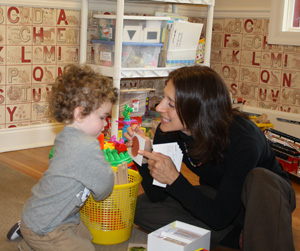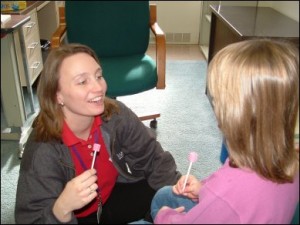Understanding Palatal Lisps
Sometimes, a child can naturally “grow out of” a lisp. However, a palatal lisp is not a developmental problem, which means that your child is not likely to grow out of it. A palatal lisp occurs when your child touches the middle of his tongue to the soft palate when he pronounces the “s” and “z” sounds.
Identifying the Palatal Lisp
Parents can identify the palatal lisp by attempting to make the sound themselves. According to speech-language pathologist (SLP) Caroline Bowen, the sound of a person with a palatal lisp attempting to produce the “s” and “z” sounds will closely mimic the production of an “h” and a “y.” Try to make these two sounds close together and prolong the sounds. If your child has been making this sound, he may have a palatal lisp.
Treating the Palatal Lisp
Taking the “wait and see” approach is not advisable with a palatal lisp. The longer your child continues to talk in this manner, the more difficult it can be to correct his speech. Bring your child to an SLP and have him evaluated as soon as possible.
Your child’s speech therapist might begin his treatment by helping him to differentiate between sounds so that he is aware of the correct pronunciation of the “s” and “z” sounds. She might also use the butterfly technique. The butterfly technique can help your child to visualize the correct placement of his tongue by imagining a butterfly. Your child will be asked to picture a butterfly while positioning his tongue so that the sides are slightly raised and lightly touch the teeth. The SLP will instruct your child to hold his tongue in this position while pronouncing the “s” and “z” sounds.
As your child masters the correct articulation of these sounds, his speech therapist will have him incorporate the sound into syllables and words. Your child will practice lists of target words with the “s” and “z” sounds in the beginning, middle, and ends of words.
Activities at Home for Palatal Lisps
Talk to your child’s speech therapist about activities that you can do with him at home to accelerate his progress. She may provide you with lists of target words to work on together. Keep your child engaged by creating games around speech therapy. Sing the words together or play word guessing games. You can also use the Seal Speech Buddy with your child. This is a simple device that provides a target in your child’s mouth to facilitate correct articulation.
It’s always beneficial to read books together with your child. Reading them aloud models correct patterns of speech for him. If he’s old enough, encourage him to read them with you. Even if your child cannot yet read, he has likely memorized some short sentences from his favorite books.





